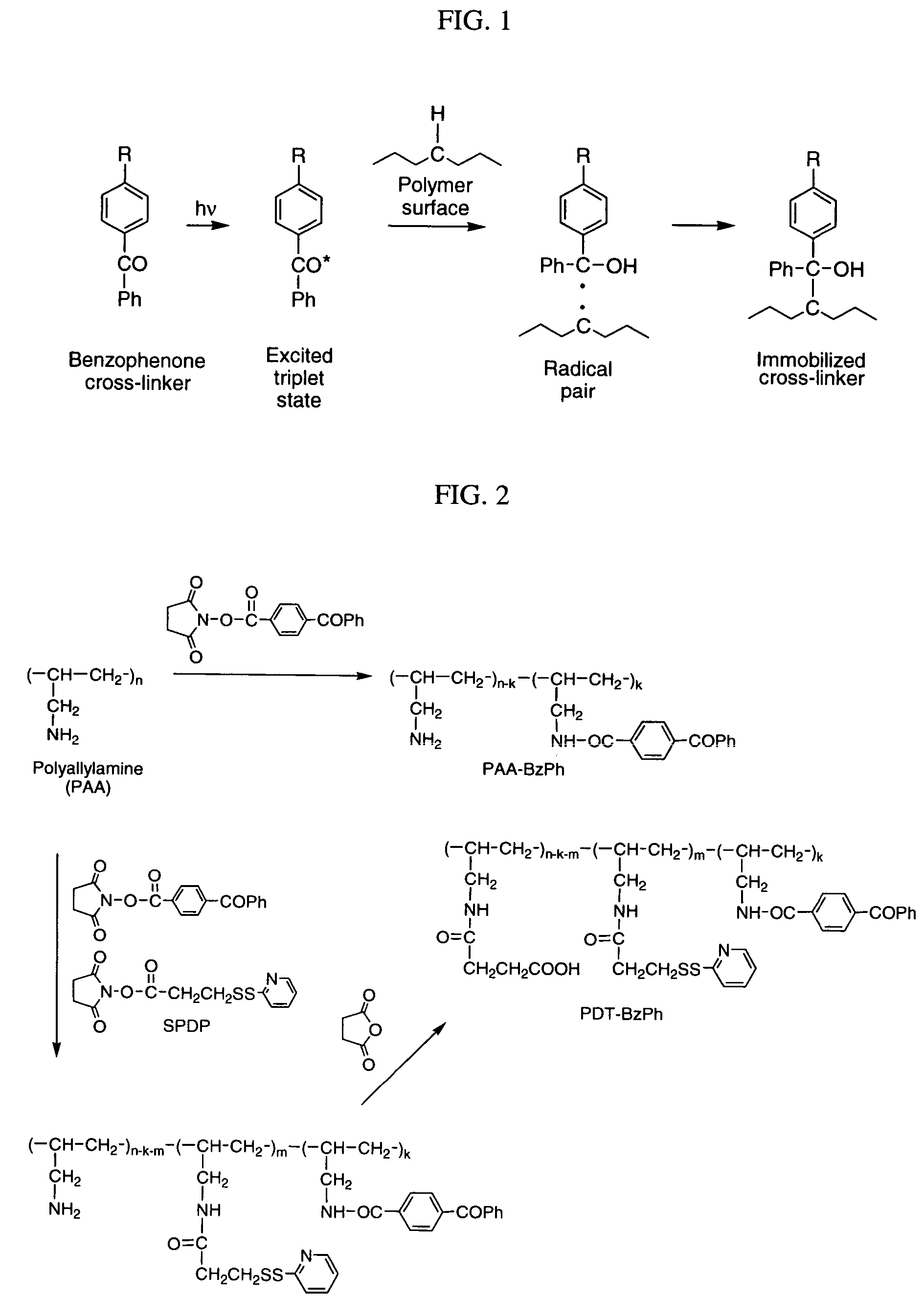Photochemical activation of surfaces for attaching biomaterial
a biomaterial and photochemical activation technology, applied in the field of surface modification, can solve the problems of limiting the level of transgene expression, ad cell entry and processing within cells via non-receptor endocytosis is a far less efficient means of vector processing, and the effect of ad cell entry and processing
- Summary
- Abstract
- Description
- Claims
- Application Information
AI Technical Summary
Benefits of technology
Problems solved by technology
Method used
Image
Examples
example 1
Preparation of Water-Soluble Photo-Activatable Polymers Based on poly(allylamine) Synthesis of PAA-BzPh
[0201] Synthesis of PAA-BzPh is demonstrated in FIG. 2. Poly(allylamine) (PAA) base was prepared from PAA hydrochloride (Sigma-Aldrich St. Louis, Mo., MW=70 KDa) by treatment in aqueous medium with a strong anionite Dowex G-55 followed by replacement of water by 2-propanol. A 5.1% solution of PAA base in 2-propanol (4.06 g, containing 3.65 mmol of amino groups) was diluted with CH2Cl2 (7 ml) and cooled on an ice bath. Succinoyl 4-benzoylbenzoate (Sigma-Aldrich, 236 mg, 0.73 mmol) in CH2Cl2 (12 ml) was added over a 10-min period. The mixture was stirred near 0° C. for 10 min, then warmed to room temperature and acidified with concentrated HCl (0.24 ml, 2.9 mmol). The resulting suspension was dried in vacuo, resuspended in CH2Cl2, and the precipitate was filtered off. After washing with CH2Cl2 and pentane, 0.544 g of PAA-BzPh hydrochloride were obtained. A 1H NMR study of this polym...
example 2
Preparation of Water-Soluble Photo-Activatable Polymers Based on Polyacrylic Acid
[0203] Polyacrylic acid can be coupled in aqueous solutions simultaneously with amino-derivatized benzophenone compound and a compound (also amino-derivatized) containing one of the reactive groups described above, particularly 2-(2-pyridyldithio)ethylamine. Water-soluble carbodiimide (EDC) can be used for such coupling (see Scheme below).
example 3
Photo-Immobilization of Polymeric Modifiers onto Matrix
Surface amination of polymeric matrix with PAA-BzPh.
[0204] An aqueous solution (2 mg / ml) of PAA-BzPh or its FITC-labeled variant was mixed with an equal volume of a buffer containing 0.1M NH4OAc and 0.05M NH3. PU Tecothane TT-1074A films or polyester (PE) fibers were immersed into the mixture for 5-60 min, rinsed with a 1% solution of NH3 and dried on a filter paper. The polymers were irradiated under an UV-lamp (UVGL-25, long wave) for 15-30 min to achieve the covalent binding of modifiers to the polymer surface. Finally, the surface modified polymers were thoroughly washed with diluted (2%) HCl and water.
Modification of polymeric matrix with PDT-BzPh.
[0205] PDT-BzPh (30 mg) was dissolved in water (30 ml) by addition of KHCO3 (20 mg) and acidified with a 20% solution of KH2PO4 (1 ml). PU films and PE fibers were soaked in the resulting mixture for 5-40 min., rinsed with 0.1% acetic acid, dried and irradiated as above. Fin...
PUM
| Property | Measurement | Unit |
|---|---|---|
| diameter | aaaaa | aaaaa |
| wavelength | aaaaa | aaaaa |
| wavelength | aaaaa | aaaaa |
Abstract
Description
Claims
Application Information
 Login to View More
Login to View More - R&D
- Intellectual Property
- Life Sciences
- Materials
- Tech Scout
- Unparalleled Data Quality
- Higher Quality Content
- 60% Fewer Hallucinations
Browse by: Latest US Patents, China's latest patents, Technical Efficacy Thesaurus, Application Domain, Technology Topic, Popular Technical Reports.
© 2025 PatSnap. All rights reserved.Legal|Privacy policy|Modern Slavery Act Transparency Statement|Sitemap|About US| Contact US: help@patsnap.com



